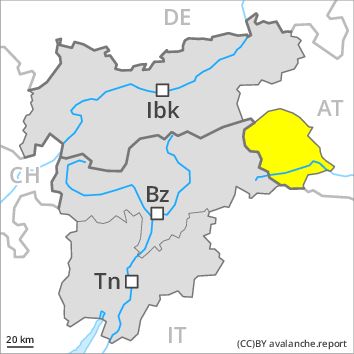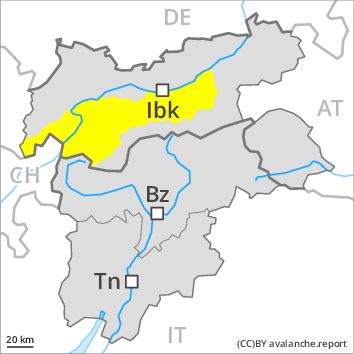Regions
Gurgler Range, Central Stubai Alps, Northern Zillertal Alps

Danger level
Danger Level 3 - Considerable above 2600m
Danger Level 2 - Moderate above 2600m
Avalanche Problem
Wind-drifted snow above 2200m, N-NE-E-W-NW
Gliding snow above 2600m, E-SE-S-SW-W

Fresh wind slabs, in particular on very steep shady slopes above approximately 2200 m adjacent to ridgelines. Gliding avalanches especially on steep grassy slopes.
As a consequence of a sometimes strong southerly wind, sometimes avalanche prone wind slabs formed. These can be released by a single winter sport participant in particular on very steep shady slopes above approximately 2200 m. The prevalence of avalanche prone locations and likelihood of triggering will increase with altitude. Caution is to be exercised in particular adjacent to ridgelines.
On steep grassy slopes more gliding avalanches are possible, especially on steep sunny slopes below approximately 2600 m. Caution is to be exercised in areas with glide cracks.
Snowpack
dp 6: cold, loose snow and wind
dp 2: gliding snow
The fresh wind slabs are lying on soft layers in particular on shady slopes above approximately 2200 m. Somewhat older wind slabs have bonded well with the old snowpack in all aspects. Faceted weak layers exist deep in the old snowpack above approximately 3000 m. The snowpack will be moist at low and intermediate altitudes.
Tendency
The avalanche danger will decrease.
Regions
Glockner Range, Eastern Deferegger Alps, Schober Mountains, Lienzer Dolomites, Venediger Range, Eastern Rieserferner Mountains

Danger level
Danger Level 2 - Moderate
Avalanche Problem
Wind-drifted snow above 2200m, N-NE-E-W-NW
Gliding snow above 2600m above 2600m, E-SE-S-SW-W

Fresh wind slabs, in particular on very steep shady slopes above approximately 2200 m adjacent to ridgelines. Gliding avalanches especially on steep grassy slopes.
As a consequence of a strong southerly wind, sometimes avalanche prone wind slabs formed. These can be released by a single winter sport participant in some cases in particular on very steep shady slopes above approximately 2200 m. Caution is to be exercised in particular adjacent to ridgelines. In high Alpine regions avalanche prone locations are more prevalent and the danger is slightly greater.
On steep grassy slopes more gliding avalanches are possible, especially on steep sunny slopes below approximately 2600 m. Caution is to be exercised in areas with glide cracks.
Snowpack
dp 6: cold, loose snow and wind
dp 2: gliding snow
The fresh wind slabs are lying on soft layers in particular on shady slopes above approximately 2200 m. Somewhat older wind slabs have bonded well with the old snowpack in all aspects. Faceted weak layers exist deep in the old snowpack above approximately 3000 m. The snowpack will be moist at low and intermediate altitudes.
Tendency
The avalanche danger will decrease.
Regions
Western Tuxer Alps, Eastern Tuxer Alps, Glockturm Range, Weißkugel Range, Silvretta, Samnaun Mountains, Northern Oetz and Stubai Alps

Danger level
Danger Level 2 - Moderate
Avalanche Problem
Wind-drifted snow above 2200m, N-NE-E-W-NW
Gliding snow above 2600m, E-SE-S-SW-W

Fresh wind slabs require caution. This applies above approximately 2200 m. Slides can occur on steep grassy slopes.
As a consequence of a sometimes strong southerly wind, sometimes avalanche prone wind slabs formed in particular in the regions exposed to the foehn wind. They can be released by a single winter sport participant in some cases especially on very steep shady slopes above approximately 2200 m. At high altitudes and in high Alpine regions avalanche prone locations are more widespread. Caution is to be exercised in particular adjacent to ridgelines. Old wind slabs are now only very rarely prone to triggering in high Alpine regions.
On steep grassy slopes only isolated moist snow slides are to be expected.
Snowpack
dp 6: cold, loose snow and wind
dp 2: gliding snow
The snowpack will be moist at low and intermediate altitudes. The fresh wind slabs are lying on soft layers in particular on shady slopes above approximately 2200 m. The somewhat older wind slabs have bonded well with the old snowpack in all aspects. Faceted weak layers exist deep in the old snowpack above approximately 3000 m.
Tendency
Fresh wind slabs represent the main danger.
Regions
Western Verwall Mountains, Eastern Verwall Mountains, Allgäu Alps, Eastern Lechtal Alps - Ammergau Alps, Mieming Mountains, Karwendel Mountains, Brandenberg Alps, Western Kitzbühel Alps, Wilder Kaiser Mountains - Waidring Alps, Eastern Kitzbühel Alps, Western Lechtal Alps, Central Lechtal Alps, Grieskogel Mountains

Danger level
Danger Level 1 - Low
Avalanche Problem
Wind-drifted snow above 2600m, N-NE-NW
Gliding snow above 2600m, E-SE-S-SW-W

Fresh wind slabs at high altitude. Slides can occur on steep grassy slopes.
Individual avalanche prone locations for dry avalanches are to be found in particular on very steep shady slopes above approximately 2600 m, especially adjacent to ridgelines. Such avalanche prone locations are rare and are easy to recognise. Individual gliding avalanches and moist snow slides are possible.
Snowpack
dp 6: cold, loose snow and wind
dp 2: gliding snow
The snowpack will be in most cases stable. At low and intermediate altitudes hardly any snow is lying.
Tendency
Low, level 1.




